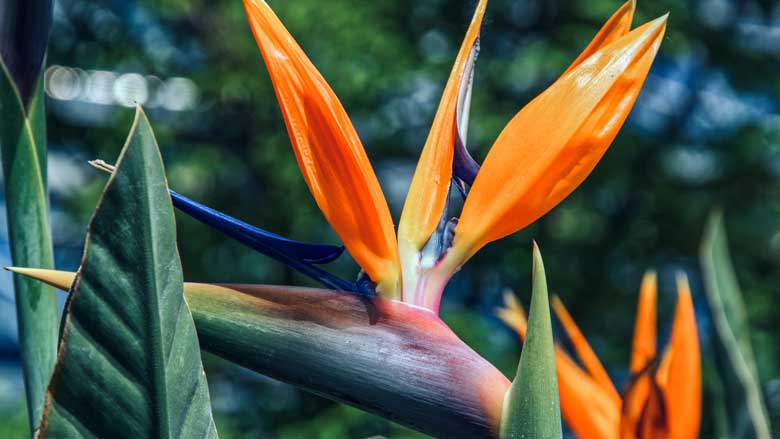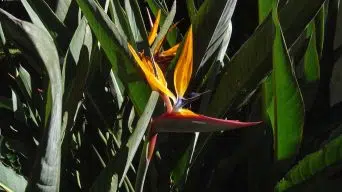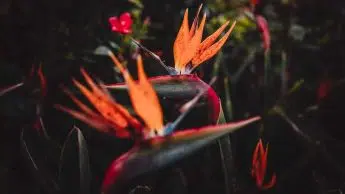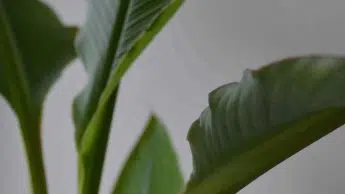White spots on a Bird of Paradise can be caused by pest infestations, powdery mildew, or sunburn. To address this issue, consider pruning affected areas and using a solution of water, alcohol, and dish soap for treatment. Proper care and environmental conditions are essential for prevention.
The Bird of Paradise (Strelitzia reginae) is a beautiful tropical plant native to South Africa.
It is grown for its large, brightly-colored flowers and its ability to thrive in warm climates.
The Bird of Paradise is a popular houseplant and is relatively easy to care for.
However, like all plants, it can occasionally develop problems.
The Bird of Paradise often encounters a prevalent issue— the emergence of white spots on its leaves. Various factors can contribute to this problem.
To tackle it, here’s a clear and concise guide on addressing white spots on Birds of Paradise.
Causes of White Spots on Birds of Paradise and Effective Treatments
Bird of Paradise plants can develop white spots for a variety of reasons.
Here are some of the most common causes of white spots on a Bird of Paradise and how to treat them:
1. Powdery Mildew
One of the most common causes of white spots on a Bird of Paradise is a fungal disease called powdery mildew.
Powdery mildew is a fungus that affects many plants, including the Bird of Paradise.
This disease is characterized by developing white or grayish-white powdery spots on the plant’s foliage.
Powdery mildew thrives in warm, humid conditions and is often seen in greenhouses or during the summer months.
It also tends to be more common in plants grown in shady areas, as they are more likely to stay moist.
You can tell if your plant has powdery mildew if a powdery substance accompanies the white spots.
Treating Powdery Mildew
If you think your Bird of Paradise has powdery mildew, you must take action immediately.
Left untreated, powdery mildew can spread rapidly and cause severe damage to your plant.
There are a few different ways that you can treat powdery mildew on a Bird of Paradise:
1. Neem Oil Application
Neem oil is a natural, organic way to treat powdery mildew on houseplants.
It works by smothering the fungus and preventing it from spreading.
To use neem oil to treat powdery mildew, mix 1 teaspoon of neem oil with 1 quart of water.
Then, using a clean cloth or sponge, apply the mixture to the affected areas of the plant.
Make sure to cover the spots completely with the neem oil mixture.
You must reapply the treatment every 7-10 days until the powdery mildew is gone.
2. Baking Soda Solution
Baking soda is another effective way to treat powdery mildew.
Mix 1 tablespoon of baking soda with 1/2 tablespoon of dish soap and 1 gallon of water to use this method.
Then, spray the mixture onto the affected areas of the plant.
You must reapply the treatment every 7-10 days until the powdery mildew is gone.
3. Pruning Affected Leaves
If your plant has a small number of leaves with white spots, you can try to remove the affected leaves.
Use sharp, clean pruners or scissors to cut off the leaves at the base of the plant.
Remove the affected leaves in the trash so they don’t spread the disease to other plants.
2. Rust
Another common cause of white spots on a Bird of Paradise is a fungal infection called rust.
Rust is characterized by the development of small, orange, or brown spots on the plant’s leaves.
A halo of white powder usually surrounds these spots.
Various fungi can cause rust, which is most common in humid or wet conditions.
It is also more likely to affect indoor plants grown in shady areas.
If you think your plant has rust, taking action immediately is crucial.
Rust can spread quickly and easily to other plants, so isolating any affected plants is essential.
Treating Rust
The best way to treat rust is to prevent it from happening in the first place.
Ensure your plants get enough air circulation, and avoid wetting the foliage when watering them.
If you see rust developing on your plant, you can remove and dispose of the affected leaves.
You can also treat the plant with neem oil, a natural fungicide.
To use neem oil to treat rust, mix 1 teaspoon of neem oil with 1 quart of water.
Then, using a clean cloth or sponge, apply the mixture to the affected areas of the plant.
Make sure to cover the spots completely with the neem oil mixture.
You must reapply the treatment every 7-10 days until the rust is gone.
3. Downy Mildew
Downy mildew, a fungal disease, induces the formation of small, circular, white spots on Birds of Paradise foliage.
Downy mildew is most common in humid or wet conditions and often affects plants grown in shady areas.
Downy mildew can be difficult to control, so it’s vital to take action when you see any signs of the disease.
Dealing with Downy Mildew
If you think your plant has downy mildew, it’s essential to take action immediately.
Downy mildew can spread quickly and easily to other plants, so isolating any affected plants is important.
The best way to treat downy mildew is to prevent it from happening in the first place.
Ensure your plants get enough air circulation, and avoid wetting the foliage when watering them.
If you see downy mildew developing on your plant, you can try treating it with a fungicide.
Many commercial fungicides are available, or you can make your own by mixing 1 tablespoon of baking soda with 1/2 tablespoon of horticultural oil and 1 gallon of water.
Spray the affected plants with this mixture once a week for several weeks to help control the downy mildew.
4. Leaf Spot
Leaf spot is a type of fungal disease that affects many different kinds of plants, including Bird of Paradise.
The Leaf spot infection is characterized by the development of small, round, brown, or black spots with white or light-colored centers on the plant’s foliage.
Leaf spot is most common in humid or wet conditions and can be spread by water droplets or wind.
Leaf spot is more likely to affect plants grown in shady areas.
Addressing the Leaf Spot Disease
If you see leaf spot developing on your plant, the best thing to do is to remove any affected leaves.
Be sure to carefully dispose of the leaves so the disease doesn’t spread.
You can also treat the leaf spot with neem oil, a natural fungicide.
To use neem oil, mix it with water according to the directions on the bottle and then spray it onto the affected leaves.
If you catch the leaf spot early, you may be able to prevent it from spreading by doing this.
5. Pest Infestation
A pest infestation is another common reason for developing white spots on a Bird of Paradise.
There are a variety of pests that can attack your Bird of Paradise, including mealybugs, spider mites, and scale insects.
Mealybugs
Mealybugs are small, wingless insects covered in a white, powdery substance.
They feed on the sap of plants and can cause great damage if left unchecked.
Mealybugs commonly infest plant foliage and stems, leading to discoloration of leaves and eventual leaf loss.
Spider Mites
Spider mites are tiny, spider-like creatures that feed on the sap of plants.
They are most commonly found in warm, dry conditions and can cause great damage to your plant if left unchecked.
Spider mites typically attack the undersides of leaves, which can cause the foliage to turn yellow or brown.
Scale Insects
Scale insects are small, wingless insects that feed on the sap of plants.
They are most commonly found in warm, humid conditions and can cause great damage to your plant if left unchecked.
Scale insects usually target plant stems and leaves, leading to discoloration such as yellowing or browning, ultimately resulting in leaf loss.
Managing Pest Infestations
Taking action immediately is essential if you think your plant has a pest infestation.
Pests can spread quickly and easily to other plants, so isolating any affected plants is important.
The first step in treating a pest infestation is to remove any affected leaves, stems, or flowers from your plant.
Once you have removed all of your plant’s affected parts, you can treat the plant with insecticidal soap or neem oil.
Insecticidal soap is a safe and effective way to kill pests on your plant.
To apply insecticidal soap, blend one tablespoon with a gallon of water, then spray the mixture evenly over your plant. Ensure thorough coverage, including the undersides of the leaves.
Neem oil is another effective way to treat pests on your plant.
Neem oil is a natural insecticide that can kill various pests, including mealybugs, spider mites, and scale insects.
To apply neem oil, blend one tablespoon of neem oil with a gallon of water, then spray the solution evenly over your entire plant, ensuring coverage on both the upper and lower surfaces of the leaves.
Treat your plant with insecticidal soap or neem oil every few days until the pests are gone.
Pests can be challenging to eliminate, so it’s important to be patient and persistent.
6. Sunburn
If your Bird of Paradise is outdoors, it may be susceptible to sunburn.
The plant’s leaves can develop white spots or patches if exposed to too much direct sunlight.
A Bird of Paradise needs a lot of light, but it should be protected from direct sunlight, especially during the day’s hottest hours.
They need to be in an area where they will receive bright, indirect light.
If you suspect your plant has sunburn, move it to a shadier spot and provide plenty of water.
Treating Sunburn
A sunburned Bird of Paradise leaf will have white patches or spots.
If you see this, moving your plant to a shadier spot is best.
Ensure you provide plenty of water, as the plant will dehydrate from sunburn.
You can also give the plant a light misting of water to help cool it down and prevent further damage.
Severe sunburn can cause the leaves to turn brown and crisp.
To aid the plant’s recovery, trim the affected leaves in such instances.
Take care not to overwater a sunburned plant, which can cause further damage.
Just give it enough water to keep the soil moist but not soggy.
7. Nutrient Deficiency
White spots on a Bird of Paradise may result from a nutrient deficiency.
A lack of iron, calcium, magnesium, or other essential nutrients can cause the plant’s leaves to develop white patches or streaks.
You can tell if your plant suffers from a nutrient deficiency if the leaves are also yellowing or the new growth is stunted.
Although a nutrient deficiency is not as common as other causes on this list, it is still something to be aware of.
Managing Nutrient Deficiency
If you think your plant is suffering from a nutrient deficiency, you can give it a fertilizer designed for tropical plants.
Fertilize your plant every two weeks during the growing season and once a month during the winter.
You can also add some compost to the soil to help provide nutrients to the plant.
8. Mineral Deposits
Mineral deposits, particularly high levels of calcium or magnesium in water, may lead to the formation of white spots on the Bird of Paradise leaves.
This is more likely to happen if you live in an area with hard water.
You can tell if mineral deposits cause the white spots on your houseplants if the spots are hard and crusty.
Handling Mineral Deposits
If you think mineral deposits cause the white spots on your plant, you can try flushing the soil with clean water.
To do this, water your plant thoroughly and drain the excess.
Every few weeks, you should do this to help remove any build-up of minerals in the soil.
To remove the white spots on your plant’s leaves, you can try scrubbing them with a soft brush and soapy water.
Preventing White Spots on a Bird of Paradise Plant
Maintaining your Bird of Paradise’s vibrant appearance and overall health hinges on preventing the development of white spots. Follow these proactive measures to keep your plant free from unsightly blemishes:
- Optimal Watering Practices: Water your Bird of Paradise appropriately, allowing the soil to dry out between sessions. Overwatering can foster fungal growth, leading to white spots. Use well-draining soil to prevent waterlogged conditions.
- Humidity Control: Bird of Paradise plants flourish in moderately humid conditions, but excessive humidity can foster fungal infections. Maintain balanced humidity by ensuring adequate ventilation and spacing between plants. Avoid excessive leaf misting, as it creates a damp environment.
- Proper Lighting: Position your Bird of Paradise in bright, indirect light, avoiding harsh, direct sunlight that can scorch leaves and make the plant susceptible to stress and diseases.
- Regular Cleaning: Remove dust and debris on leaves, which can contribute to white spot development. Gently wipe the leaves with a damp cloth to enhance appearance and reduce the risk of pests and diseases.
- Quarantine New Plants: Before introducing a new plant to your Bird of Paradise’s environment, quarantine it for a few weeks to monitor signs of pests or diseases. This precautionary measure prevents potential issues from spreading to existing plants.
- Appropriate Fertilization: Maintain a regular fertilization schedule with a balanced, water-soluble fertilizer. Avoid over-fertilizing to prevent salt buildup in the soil, which can stress the plant and increase disease susceptibility.
- Prompt Pest Management: Be vigilant for pests like spider mites, which can damage leaves and create entry points for infections. Address pest issues promptly with natural or chemical treatments, depending on your preference and the severity of the infestation.
Incorporate these preventive measures into your Bird of Paradise care routine to significantly reduce the risk of white spots. This ensures your plant thrives in a healthy and visually appealing environment.
Final Thoughts
White spots on a Bird of Paradise not only diminish its aesthetic appeal but can also impact the plant’s overall health. Fortunately, a swift and straightforward resolution is possible through appropriate treatment.
To address white spots on your Bird of Paradise, consider the following steps:
- Identify the Cause: Begin by pinpointing the root cause of the issue. This initial step is crucial for selecting the most effective treatment method.
- Be Patient and Consistent: Consistency is key in treating white spots. It’s essential to be patient as it might take a few weeks for the spots to vanish entirely.
- Provide Adequate Care: Ensure your plant receives the necessary care to maintain its health and prevent future problems.
By following these guidelines, you can ensure the longevity and beauty of your Bird of Paradise. With proper care, it will thrive for years to come.







